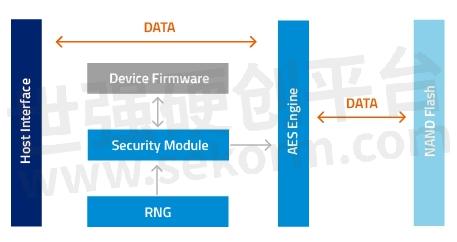SecurStor-enabled ATP Flash Storage Devices Secure Your Data with AES-256 Encryption

Cybercriminals are always on the prowl, looking for weak links to break and crack. How can users, especially in this increasingly connected world, have complete assurance that their data is safe, wherever it may be located?
Encryption is one of the most common ways to protect sensitive data. Encryption works by taking plain text and converting it into cipher text, which is made up of seemingly random characters. Only those who have the special key can decrypt it. AES uses symmetric key encryption, which involves the use of only one secret key to cipher and decipher information.
The Advanced Encryption Standard (AES) is the first and only publicly accessible cipher approved by the US National Security Agency (NSA) for protecting top secret information. AES was first called Rijndael after its two developers, Belgian cryptographers Vincent Rijmen and Joan Daemen.
The following illustration shows how symmetric key encryption works:

Figure 1. Symmetric key encryption
AES-256, which has a key length of 256 bits, supports the largest bit size and is practically unbreakable by brute force based on current computing power, making it the strongest encryption standard. The following table shows that possible key combinations exponentially increase with the key size.

Table 1. Key sizes and corresponding possible combinations to crack by brute force attack.
Source: https://www.eetimes.com/document.asp?doc_id=1279619#
SecurEncrypt: Rock-Solid AES-256 Encryption on ATP Flash Storage Devices
SecurStor-enabled ATP flash storage devices feature SecurEncrypt with AES-256 encryption to safeguard data against unauthorized access.
They make use of a hardware-based set of security modules and an AES engine. When the host writes data to the flash storage device, a Random Number Generator (RNG) generates the 256-bit symmetric cipher key, which is passed to the AES engine. The AES engine encrypts the plain text (source data) into cipher text (encrypted data) and sends it to the NAND flash for storage.
Inversely, if the host wants to retrieve data from the storage device, the AES engine decrypts the cipher text in the NAND flash, and then transmits data to the host as plain text. The encryption/decryption process is done at the flash level and does not require host intervention, so there is no performance degradation and data transfer does not slow down.

Figure 2. AES-256 encryption mechanism in ATP SecurEncrypt
ATP SecurStor: Protection Beyond Encryption
SecurEncrypt using AES-256 encryption is one component of ATP SecurStor, a multi-level security suite that protects data with a variety of options beyond data-at-rest encryption. Customers can choose from features that can be customized according to their application-specific requirements to guard against unauthorized access, illegal copying and other security threats to ensure data, OS and firmware integrity at all times.
- +1 Like
- Add to Favorites
Recommend
- SMART DuraFlash BGAE540 EMMC Is a Soldered-down Flash Storage Solution Provides Stable High-density Embedded Storage
- Alliance Memory Expands Serial NOR Flash Portfolio With New High-Density Devices, Offering Increased Storage and Performance for a Wide Range of Applications
- Alliance Memory to Highlight Latest SRAM, DRAM, Flash, and Storage Memory ICs at Embedded World 2022
- IoT and IIoT: Flash Storage, Sensors and Actuators in Cloud/Edge
- SMART’s DuraFlash N200 SATA M.2 2242 SSDs Provide an Economic Yet Highly Reliable Mass Storage in a M.2 Form Factor
- News | NAND Flash Storage Solutions for the Data-Driven 5G Era | ATP
- Speed and Storage: The Role of Flash Memory in the Automotive Industry
- SMART Modular Introduces PCIe NVMe Flash Storage Products in M.2 Type 1620 BGA Package and M.2 2230 Module
This document is provided by Sekorm Platform for VIP exclusive service. The copyright is owned by Sekorm. Without authorization, any medias, websites or individual are not allowed to reprint. When authorizing the reprint, the link of www.sekorm.com must be indicated.






























































































































































































































































































































































































































































































































































































































































































































































































































































































